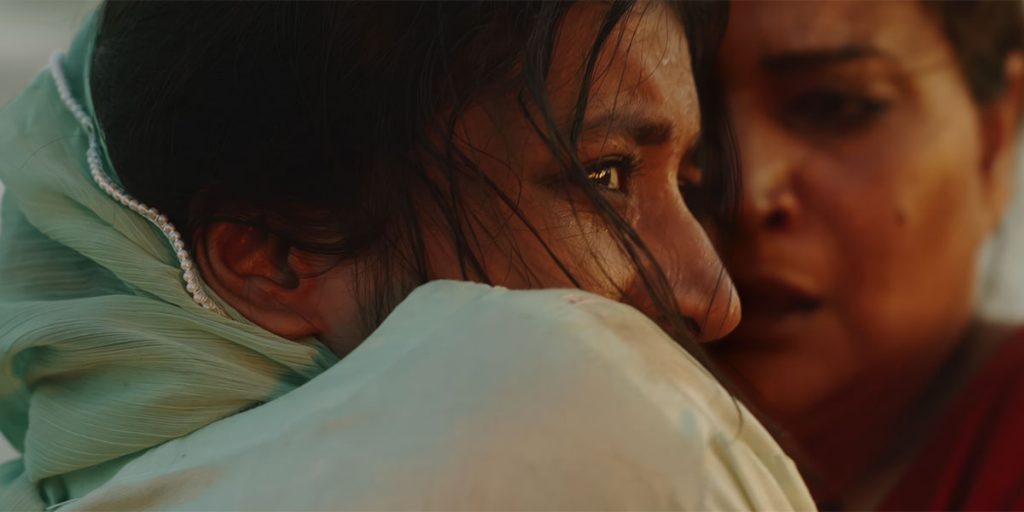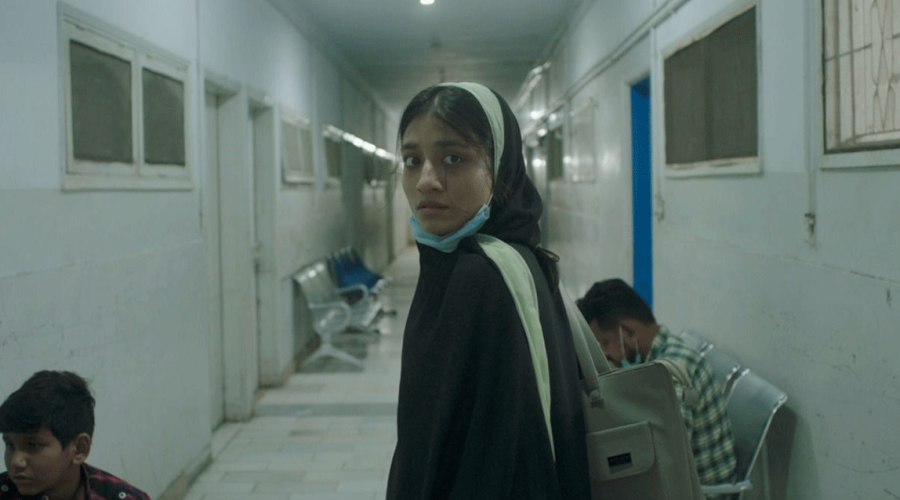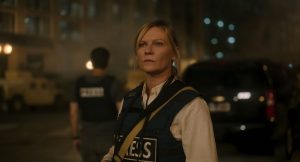Reviews include Irena’s Vow, The Beast, and Before I Change My Mind.
Zarrar Kahn, Anam Abbas on In Flames and forging new territory in Canadian cinema
September 28, 2023

“It’s time for Canadians to be on the world stage,” says In Flames writer-director Zarrar Kahn.
Kahn and producer Anam Abbas are riding the success of their film In Flames after premiering at Cannes’ Directors’ Fortnight, followed by a Canadian debut at the Toronto International Film Festival (TIFF) and a west coast premiere at the Vancouver International Film Festival (VIFF) this week. Their film is a beautifully haunting story about women forced to navigate their oppressive, patriarchal society layered in an eerie ghost story.
“I would describe In Flames as a drama with horror beats because the horror is an extension of the psychology of the characters’ experience,” said Kahn during an interview at TIFF.
The film follows Mariam (Ramesha Nawal), a medical student in Karachi, Pakistan who struggles to keep her family together after the loss of her grandfather. She consoles her grieving mother (Bakhtawar Mazhar) and brother – all while preparing for her upcoming exams. After a motorcycle accident, Mariam finds herself even more alone while being stalked by something through the streets, a force she can’t understand.
Kahn, who makes his feature directorial debut with In Flames, explained that while working as an artist, he was falling more deeply in love with the world and genres of cinema. He soon realized that his film was very much a horror: “We need to lean into that tension because there’s so much horror in the lived experiences of these characters,” Kahn says. “I want people when they watch this film to be in the shoes of Mariam and Fariha, to be suffocated, to feel like you’re always being watched, to feel what that is like and why it shouldn’t be, and how much power there is in their resistance.”
Kahn recognizes that marginalized creators who haven’t been able to access the production tools they need have often been attracted to horror. Kahn and Abbas are also very hopeful of the future of Canadian cinema and the global stage of storytelling, including Canadian-South Asian stories. Read our entire conversation below.
The film has got such great recognition so far from everyone at Cannes and at home at TIFF. How does this all feel?
Zarrar: It feels amazing. Being a micro-budget Talent to Watch film [a stream of Telefilm Canada that provides funding for emerging filmmakers], we had ambitions for the film, but it superseded anything we could have hoped for. I dreamt of being at Cannes and to have that validation. Then to just screen it with all of our cast and crew from all over the world flying in and getting to do that again at TIFF is a filmmakers’ dream come true. It’s been incredible.
Anam: Making the film was such an adventure and so much fun. I don’t think I was thinking too far ahead and it was an enjoyable experience. Sometimes, when you’re in the depths of hell, you’re just like, “Oh this better be worth it.” But the process has been great and it’s such a fun team.
How did this collaboration come to be?
Zarrar: I saw the trailer for a documentary that Anam made a long time ago. We’re both Pakistani-Canadian, we both have a foot in creating in both worlds. This has been such a fulfilling collaboration. Anam is trailblazing and we have a similar perspective to cinema, towards the industry, and towards our approach [towards] creating these stories, both behind the camera as well as in front of the camera. Finding collaborators like that in this industry is so rare, so when you do, you hold on to them.
Anam: I’ve seen Zarrar’s previous shorts, and every one was so exciting and different. When a filmmaker is dedicated to developing their craft, that’s an exciting person to work with because he’s good at what he does, but also I knew that everything he’s done before would be coming to another level. I come from the documentary space. I’ve been developing in Pakistan and Canada through documentary, but he’s been doing so many shorts. I also like [how] the team that I was walking into had that relationship with him and the city. Working in Karachi with an indie crew is not easy because there’s not many people working in the space. It was a treat to collaborate and create in the environment where there were such deep roots for him.
I love horror and I love seeing South Asians occupy this space using this horror theme. Why is horror a vehicle often used to tell tougher stories?
Zarrar: I think marginalized communities or creators who haven’t necessarily been able to access the tools to production have been attracted to horror because horror has always been outsiders. Horror has always been [made by] storytellers and has long been looked down upon as B-cinema, and only now, we’re having conversations about “elevated horror,” but what is “elevated horror”? It was always elevated. The metaphor [of horror] allows people who wouldn’t have had the tools or the ability to speak about things that are so terrifying in their communities in a way that’s accessible to audiences.
I didn’t grow up watching arthouse cinema, I grew up watching Disney movies and Bollywood films…films that were larger than life. Film school also wasn’t an option for me, so you end up watching “big” films. As you grow older, those films are horror movies, and you want to create that experience in the cinema with your family and your friends together. As my voice as an artist developed, and I did get to discover world cinema artists like Bertolucci…I wanted to marry those twin passions with the style of storytelling that attracted me.
Tackling a story about patriarchy is never an easy conversation. Was that always the central theme of this story?
Zarrar: The mother-daughter relationship was there from day one and also the mother-daughter estrangement. That was something I knew would be the heart of the film if the audience bought their relationship despite the fact that they’re not close for a large chunk of the film and they’re also not going to be framed together. So much rested on the performances from Bakhtawar Mazhar and Ramesha Nawal. They’re both incredible actresses. They’ve been so generous sharing their stories and their experiences and in the short film as well. Working with [Ramesha], I was able to write this character: I’m a man of a certain age, so I don’t know what it’s like to be a woman of a certain age navigating Pakistani society. [We had] the right collaborators, people like on Anam, people like DP Aigul Nurbulatova—it was important to have a female cinematographer on a film that speaks about patriarchy.
Anam: I come from this politicized space and the doc industry has historically had a certain point of view of Muslim women and Pakistan. It very much related to the war industry. It’s a victimized portrayal. From the get-go, I was like, “We cannot [do that].” It’s hard because, at the end of the day, the gaze is international. You want an authentic story, you want to tell a story that is steeped in lived experience. But at the end of the day, the gaze might still be a colonizer’s gaze. But I think that the intention of the film speaks louder.

A Canadian film can tell so many stories and, especially now, we are seeing so much more. How do you think the Canadian film landscape has changed and is changing?
Anam: We’re definitely forging new territory. I think that the immigrant experience and the immigrant community in Canada, at least for South Asians, is different from the U.K. or the U.S. Because we’re newer immigrants, we’re much more connected to our home countries or parents’ home countries. We’re in a moment for Canadian cinema where the institutions are catching up and letting us create in our languages, which are also Canadian languages. Statistically, it makes sense for us to be telling these stories.
We met our EP Shant Joshi at the Berlinale project market. We were pitching before the pandemic and he had just done Talent to Watch. He’s very active in the BIPOC community and he said, “You know what? There is a space here. Let’s try.” We’re very grateful for Telefilm for being open-minded and believing in the projects. We were trying to not be stuck in some other idea of what Canadian cinema is. Riceboy Sleeps was also such a great success, so we’re in a community of a new generation of filmmakers.
Zarrar: Looking at the legacy of Canadian cinema, there has always been South Asian storytelling. There are people like Deepa Mehta…we’re just seeing more of it now but that legacy of trailblazers was there. Now we as a community are more vocal and, post-COVID, people are going after what they want and going after it with their whole heart. We’re seeing that in this new wave of filmmakers doing advocacy work ourselves, of doing the work, but also working with institutions. I’m so excited to be a part of this wave of films, like Riceboy Sleeps, The Queen of My Dreams—all these exciting filmmakers who are creating without a lot of resources, but telling stories with a lot of heart. That’s where the change will come for what Canadian cinema looks like and [how it is] perceived on a global stage.
What else would you like to see tackled in Canadian cinema, given the diversity of stories?
Zarrar: I’m excited about the next wave of Indigenous storytelling. That community needs a greater allocation of resources. I want to see that community championed more. I like seeing what French cinema does where they’re able to take a Canadian producer and a Canadian director but work with teams from across the world. That’s also how they become cultural ambassadors. That’s how French cinema has that position in the world. Like why can’t Canada have that? After France, Canada has the richest model of public financing for films. We need to have that global approach, especially in terms of how accessible cinemas is these days. It’s time for Canadians to be on the world stage.
Having gone through this experience, as director and producer, how have you set new goals for yourself in terms of what you would like to accomplish?
Zarrar: I want a bigger toolbox…Anam knows this. [Laughs.] I want to keep telling stories that are challenging, that break the status quo. I want more tools, man—I want a rain machine! The craft of being on set—I’m really looking forward to getting back on it and there’s so much interesting conflict happening in Canada, right now, and now that I’m back in Toronto. Especially working with young people, I’m getting to know the challenges and the barriers in the industry right now. As a young racialized creator, that’s something that I find fascinating.
Anam: It’s exciting when you get this kind of success making something that was new and fresh. You’re empowered to be like, “Let’s take more risks.”



